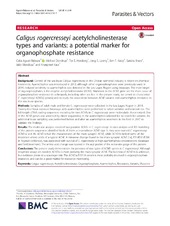| dc.contributor.author | Agusti-Ridaura, Celia | |
| dc.contributor.author | Dondrup, Michael | |
| dc.contributor.author | Horsberg, Tor Einar | |
| dc.contributor.author | Leong, Jong S | |
| dc.contributor.author | Koop, Ben F | |
| dc.contributor.author | Bravo, Sandra | |
| dc.contributor.author | Mendoza, Julio | |
| dc.contributor.author | Kaur, Kiranpreet | |
| dc.date.accessioned | 2019-03-22T15:03:42Z | |
| dc.date.available | 2019-03-22T15:03:42Z | |
| dc.date.issued | 2018-10-30 | |
| dc.Published | Agusti-Ridaura CA, Dondrup M, Horsberg TE, Leong JS, Koop BF, Bravo S, Mendoza J, Kaur K. Caligus rogercresseyi acetylcholinesterase types and variants: a potential marker for organophosphate resistance. Parasites & Vectors. 2018;11(1):570 | eng |
| dc.identifier.issn | 1756-3305 | en_US |
| dc.identifier.uri | https://hdl.handle.net/1956/19234 | |
| dc.description.abstract | Background Control of the sea louse Caligus rogercresseyi in the Chilean salmonid industry is reliant on chemical treatments. Azamethiphos was introduced in 2013, although other organophosphates were previously used. In 2014, reduced sensitivity to azamethiphos was detected in the Los Lagos Region using bioassays. The main target of organophosphates is the enzyme acetylcholinesterase (AChE). Mutations in the AChE gene are the main cause of organophosphate resistance in arthropods, including other sea lice. In the present study, we aimed to characterize C. rogercresseyi AChE(s) gene(s) and to study the association between AChE variants and azamethiphos resistance in this sea louse species. Methods Samples of adult male and female C. rogercresseyi were collected in the Los Lagos Region in 2014. Twenty-four hour exposure bioassays with azamethiphos were performed to select sensitive and resistant lice. The full-length cDNA coding sequences encoding for two AChEs in C. rogercresseyi were molecularly characterized. One of the AChE genes was screened by direct sequencing in the azamethiphos-selected lice to search for variants. An additional louse sampling was performed before and after an azamethiphos treatment in the field in 2017 to validate the findings. Results The molecular analysis revealed two putative AChEs in C. rogercresseyi. In silico analysis and 3D modelling of the protein sequences identified both of them as invertebrate AChE type 1; they were named C. rogercresseyi AChE1a and 1b. AChE1a had the characteristics of the main synaptic AChE, while AChE1b lacked some of the important amino acids of a typical AChE. A missense change found in the main synaptic AChE (1a), F318F/V (F290 in Torpedo californica), was associated with survival of C. rogercresseyi at high azamethiphos concentrations (bioassays and field treatment). The amino acid change was located in the acyl pocket of the active-site gorge of the protein. Conclusions The present study demonstrates the presence of two types of AChE1 genes in C. rogercresseyi. Although enzymatic assays are needed, AChE1a is most probably the main synaptic AChE. The function of AChE1b is unknown, but evidence points to a scavenger role. The AChE1a F/V318 variant is most probably involved in organophosphate resistance, and can be a good marker for resistance monitoring. | en_US |
| dc.language.iso | eng | eng |
| dc.publisher | Springer Nature | en_US |
| dc.rights | Attribution CC BY | eng |
| dc.rights.uri | http://creativecommons.org/licenses/by/4.0/ | eng |
| dc.subject | Caligus rogercresseyi | eng |
| dc.subject | Acetylcholinesterase | eng |
| dc.subject | Organophosphate | eng |
| dc.subject | Azamethiphos | eng |
| dc.subject | Resistance | eng |
| dc.subject | Variants | eng |
| dc.subject | Mutation | eng |
| dc.title | Caligus rogercresseyi acetylcholinesterase types and variants: a potential marker for organophosphate resistance | en_US |
| dc.type | Peer reviewed | |
| dc.type | Journal article | |
| dc.date.updated | 2018-12-19T09:27:14Z | |
| dc.description.version | publishedVersion | en_US |
| dc.rights.holder | Copyright The Author(s) 2018 | en_US |
| dc.identifier.doi | https://doi.org/10.1186/s13071-018-3151-7 | |
| dc.identifier.cristin | 1644981 | |
| dc.source.journal | Parasites & Vectors | |

